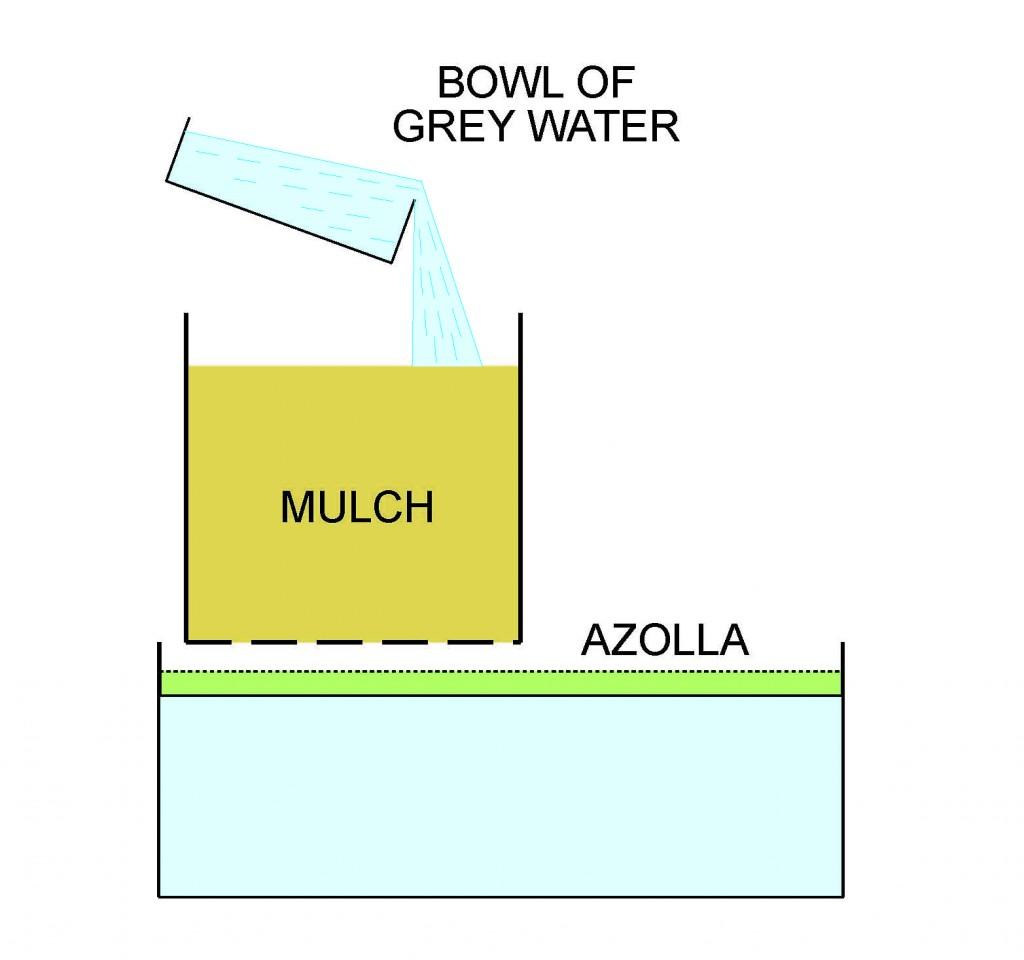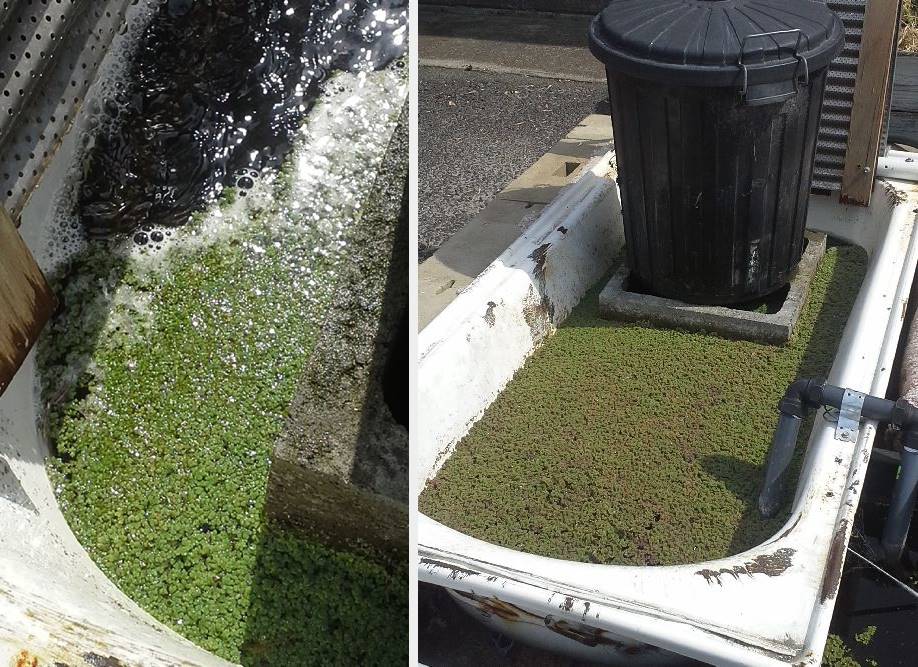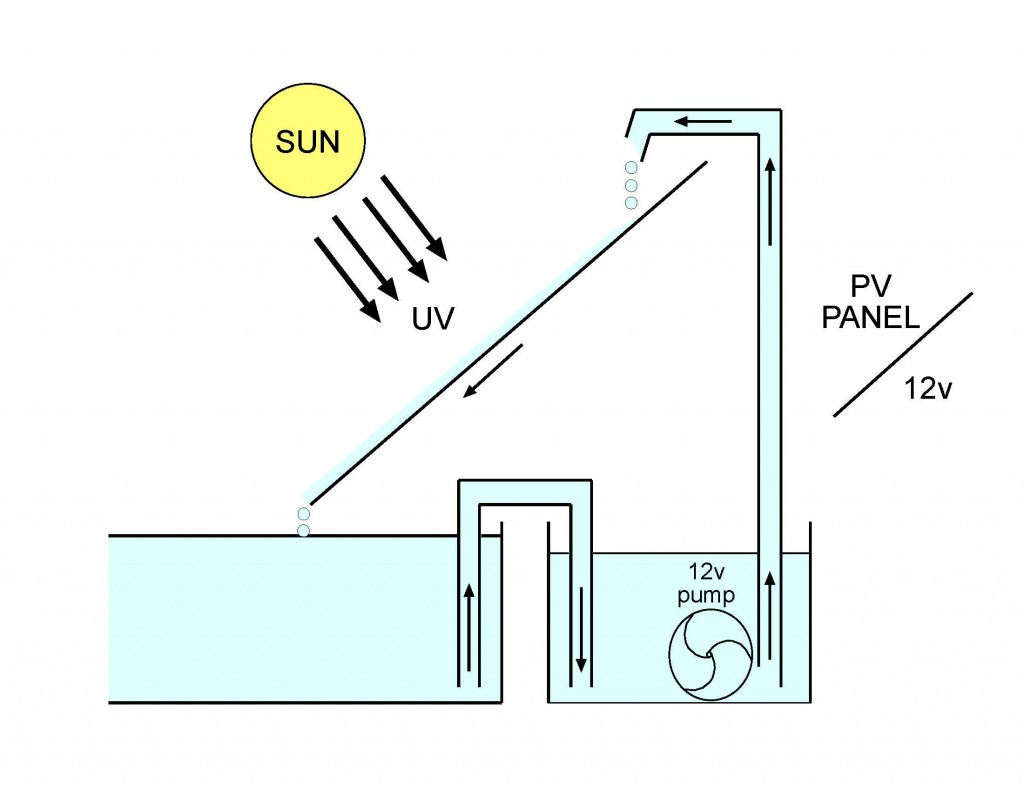 Kitchen grey water treatment, storage and re-use
Kitchen grey water treatment, storage and re-use
Alan J. Marshall
17 November 2015
KITCHEN GREY WATER
Kitchen Grey Water is water that has been used for food preparation and cleaning crockery, cutlery and cooking utensils including greasy pans.
The storage of Kitchen Grey Water can give rise to anaerobic conditions which promote putrid smells and increase of pathogens.
The re-use of untreated Kitchen Grey Water is restricted because of potential contamination and structural breakdown of soil by oils and fats, sodium salts that result from the use of soaps and detergents.
The following description demonstrates a low-cost, practical treatment of Kitchen Grey Water that will achieve the requirements of Storage and Re-use.
Note that ‘General Grey Water’ refers to sullage deriving from lavatories, showers, wash basins and laundries, which has the potential to carry pathogenic organisms. This risk is reasonably regarded (but debatably) absent from Kitchen Grey Water and thus making the entire treatment process simpler and easier to safely manage.
EXPERIMENTS
Over the past three years the author has conducted numerous experiments in the use of azolla for removing polluting nutrients from grey water. These have been small, domestic experiments, based on the established fact that azolla is able to reduce phosphates in water.
Phosphates accumulate in plant tissues and facilitate energy transfer during the process of photosynthesis. Decomposition of plant material by fungi, bacteria and soil biota releases phosphates and other nutrients. The experiments investigated different processes involving water that is passed through a zone of decomposition which carries nutrients into a pond where azolla is growing.
The experiments were conducted to determine if sufficient phosphate would be provided by the system to enable azolla’s growth on a sustainable and continuing basis.
The following text, diagrams and photographs show the proposed system resulting from the experiments. This may be upgraded based on future experiments.
KITCHEN GREY WATER – MULCH FILTER – AZOLLA POND

Diagram showing the process of adding grey water to mulch above a container of water with azolla floating on the surface.
Kitchen Grey Water is added daily and contains detergents, various proprietary cleaning agents, food particles, grease, fats and oils.
The mulch consists of chipped leaves, twigs, fungi, earth worms, etc. The pond receives nutrients from material decomposed within the mulch.
Azolla feeds on those nutrients.
Water effluent is transferred to a second pond as shown below, from which it can then be harvested for safely watering food plants.
As water drops into the second tank (shown on the right), it is siphoned back from the azolla pond.
The effluent water is re-circulated by a small 12v solar-powered bilge pump to the azolla pond (shown on the left) via a cascade, enabling it to be aerated and irradiated by UV from the sun.
In the photograph below, it can be seen that lid of the mulch bin is acting as the cascade. This is temporary. A better arrangement will be designed later.
The resulting mulch is shown below.
 The Mulch bin shown above serves as a convenient surface over which to cascade water.
The Mulch bin shown above serves as a convenient surface over which to cascade water.
Azolla was harvested 3 days before this photograph, and is growing back quickly.
The water in which azolla is grown is also used for the garden.
Note that the illustrated system is exposed to too much sunlight. Shading will be erected over half of the surface in the next set of experiments, to show the advantageous effect of up to 70% shade.
The picture shown above was taken 12 days after the previous harvesting, showing that growth has progressed extremely well. It shows that the nutrient levels in the water obtained from the mulch are more than adequate for azolla’s growth. No other fertiliser has been added.
A bowlful of the azolla was harvested, top-dressed around brassicas, and some of it was dug into the topsoil for planting Oca (Oxalis tuberosa).
UPDATE 5 JANUARY 2016
A rudimentary cascade has been mounted. This takes over the job of aeration where previously water was passed over the mulch container lid. This modified cascade is working efficiently. Other methods and configurations could be tried, depending on the designer’s ingenuity.

Syphon: 19mm pipe was initially used. This easily became blocked with debris that accumulates on the bottom of the pond. Debris consists of decaying plant matter shed by azolla. A 25mm (1 inch) pipe is now used and it is able to keep water level maintained and balanced with pump output.

Phosphate: Azolla’s growth was very adequate for the first 2 weeks, presumably getting sufficient phosphate from mulch decomposition. Thereafter azolla’s growth slowed. There were no aerial fronds, each plant remaining very small.
A small quantity of Chicken Manure pellets was distributed over the mulch surface, then sprayed with 8 litres of water. Within 24 hours following this application, there was a very marked improvement in azolla’s growth. This is further proof that nutrients obtained only from mulch decomposition are not sufficient to sustain azolla’s growth under these conditions.
The author’s suggestion is that to apply un-composted, dry and perhaps dusty chicken manure which has not been pelleted, could present a health hazard to humans. Pellets might not be available at a reasonable price in many communities.
A useful alternative source of phosphates is urine. The author is now applying approximately 200ml (less than 1/2 pint) of early morning urine to the mulch every 2 days. azolla continues to grow well and is harvested every 5-6 days.

UPDATE 18 JANUARY 2016
With sufficient nutrients applied, azolla is growing well, showing green instead of
pink, and is doubling its mass in approximately 3 days.
We are in mid-summer here now in Tasmania, with warm dry weather and plenty of direct sunshine to azolla.
Water temperature 26°C. pH 7.5 ++ (exceeds upper limit of my pH Test Kit).

Photo on the left shows re-circulated water entering via the cascade, producing lots of bubbles. My guess is that tannin in the water acts as a surfactant*. This presumably increases oxygen levels due to extra surface area.
(* a substance which tends to reduce the surface tension of a liquid in which it is dissolved.)
Azolla certainly seems to like this arrangement. Young, small-leafed plants arise at this point and gradually move through the pond as they grow and mature. So that, in photo on the right, the entire surface is covered with very healthy azolla, nicely green because of adequate phosphate.
Another source of phosphate: I have been sweeping up dry duck and goose droppings and add these to my mulch filter each week.
PLANNED DEVELOPMENTS
The program has the following ongoing objectives:
- Obtain laboratory analysis of the liquid coming from the mulch, to determine whether sufficient phosphate does enter the azolla pond.
- Analyse the final effluent to determine its value as a fertiliser.
- Determine the harvested azolla’s potential as a food for people, as a livestock feed, and as a fertiliser.
- Design a larger mulch filter that can be used for an up-sized grey water system, including formats suitable for a commercial kitchen.
- Develop a practical method for moving the grey water distribution over a series of mulch filters, for example, using one per day over 7 bins, with a resting period of 7 days.
- Design an integrated composting system, as the mulch will gradually be broken down to a soil-like structure and will need to be renewed on a regular basis. The resulting bi-product will be an excellent compost.
You can view Alan Marshall’s system in the videos below:
For more information, please contact Alan Marshall: anakial193@gmail.com
© Alan J. Marshall 18 January 2015





